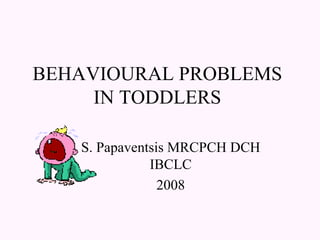
Behavioural problems in toddlerhood
- 1. BEHAVIOURAL PROBLEMS IN TODDLERS S. Papaventsis MRCPCH DCH IBCLC 2008
- 3. Mother’s description of their toddlers 70% 72% 83% Temper outbursts 85% 92% 95% Stubborn 36% 18% 17% Has nightmares 56% 52% 52% Awakens during the night 56% 46% 70% Resists going to bed 37% 26% 50% Eats too little Age 4 Age 3 Age 2 Behaviour
- 5. The age of developing everyday habits 3-5 years Eating 4-6 years Self-care 2-4 years Toiletting 1-3 years Dressing and undressing 4-12 months Sleep routine 4-12 weeks Regular feeding TIME HABIT
- 19. Hyperactivity at age 10 years and social class Social class Hall D, Health for All Children , 4 th edition, 2003
Notas do Editor
- Normal need not be average and not average is not nessecarily abnormal
- Green
- Testing their limits and power near the mother Changing their minds all the time Magical thinking: Piaget’s preoperational stage of development Focusing only on their own needs and happiness/ being self-centred
- Some behaviours are common early Lying, breath holding, defiance are common in 2-4 yr olds
- It is a relieving theory for those parents who cannot find anything from therselves on their children/ Help them accept some characteristics without feeling responsible for having caused them Activity Regularity Approach and withdrawal Adaptability Stimuli thershold Intensity Mood Attention span Distractibility Self-control
- 1966: 133 children followed up from birth to adulthood Negative, easily frustrated Negative, loud, overactive, crying, frustrated, irregular sleeping and eating/ even with the most perfect parents
- David Hall, Health for All Children, 4 th edition Disability Survey by the UK Office of Populations, Censuses and Surveys 1985-1988/ Bone M and Meltzer H Point prevalence among 3 yr olds for polymorphous behavioural problems(combination of tntrums,overactivity,aggression, clinging etc) is about 10% 7% have moderate or severe behaviour problems, as defined by their parents (Polnay L, Community Paediatrics, Churchill Livingston) Polymorphous: Over activity, disobedience, temper tantrums, aggressive out bursts under 3yrs
- Causing distress to child, parents or neighbours Tantrums, agression, overactivity, eating/ sleeping/ continence problems, unusual habits
- Children who fail to gain reasonable control of their anger and tempers by 5 years are likely to continue to have problems with aggression (Polnay)
- Although most behaviours are non-specific and may or may not indicate an underlying disorder, a few almost invaraibly indicate significant abnormality It signifies at least poor supervision Polnay L, Community Paediatrics
- Exposed to unknown environment Ie when a child cries in the middle of the night and receives a cuddle, he engages the mother to a false cycle to get more comfort Erkison psychosocial theory
- Ie divorce, only parenrt
- First, poor children are more likely to be exposed to risk factors which are postitively related to adverse outcome (ie maternal depression). Second, the effects of these risk factors tend to be greater than they are for non-poor children The families who might benefit the most from help with behavioural problems are less likely and often unable to make use of the strategies suggested
- SOFT: touch, smile, praise, attention HARD: sticker, sweets etc
- Ignoring the inappropriate ( after stating it is) Not delayed
- Polnay Divert the child’s attention Say to the child that the response is unacceptable Time out: a safety valve to avoid escalation: separate in another room/ Don’t lock the door Selective deafness and blindness
- Patience, persistence and consistency
- Duration 1 hr in infants, 1,5 in adults
- They get comforted and enjoy attention. When they get better they continue to play the game
- BH, PMH, FH, examination, development unremarkable
- Constant bedtime, avoid overstimulation before, calm them down-story, bath, cuddle-, minimal light, close the door decisively aftersaying goodnight Let the child cry for a short period, then give some incomplete comfort and walk away, let them cry a little longer each time, giving more incomplete and delayed comfort, until the child understands that he doesn’t gain reward when wakening